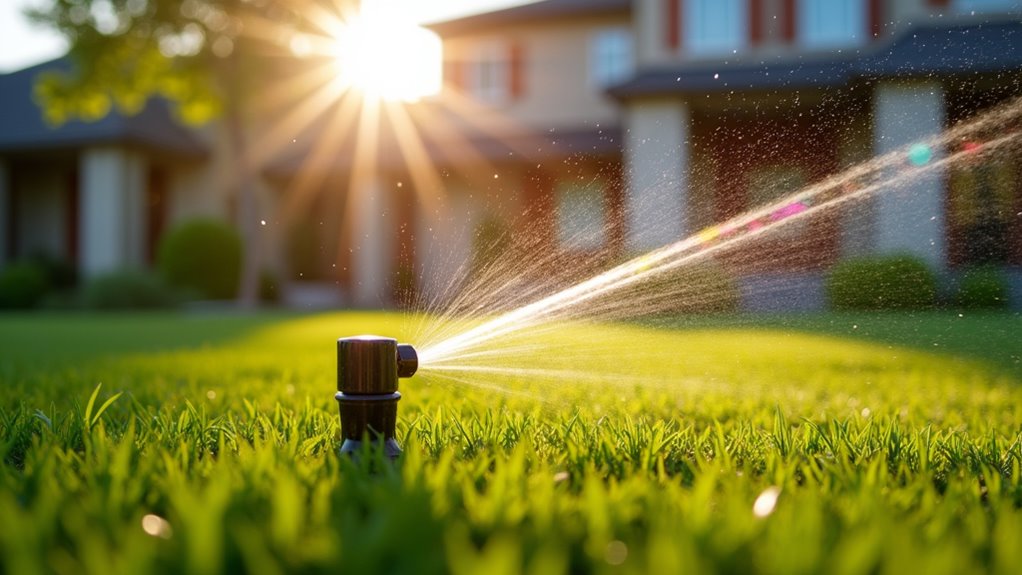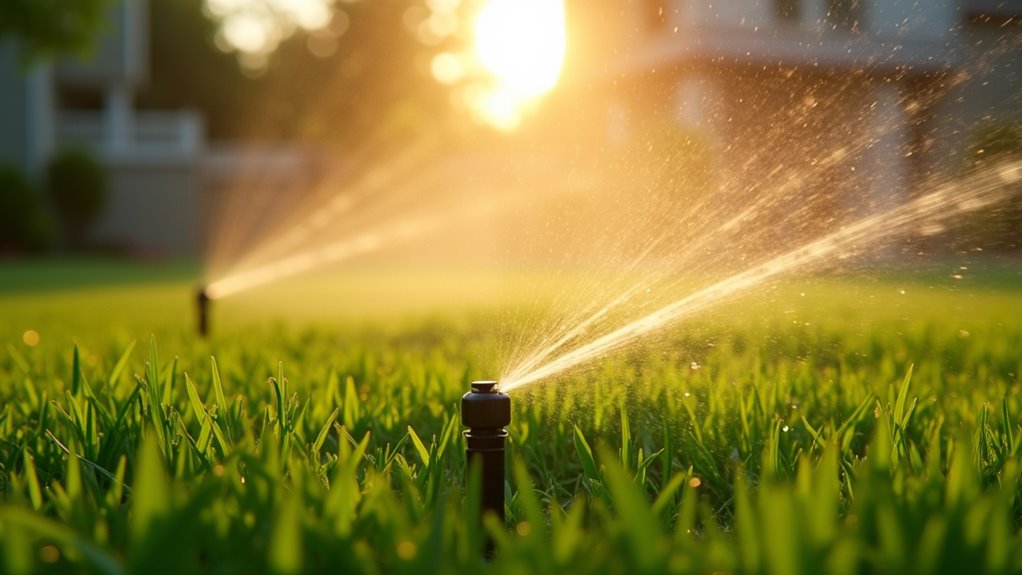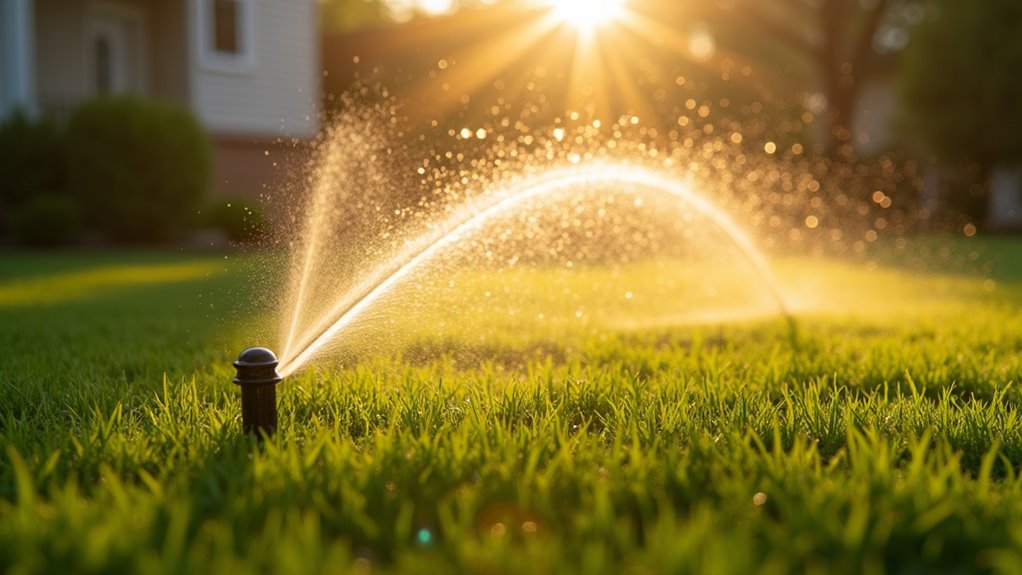To set up low-voltage outdoor lighting, start by sketching a detailed layout plan marking fixture locations and calculating total wattage requirements. Next, gather essential tools including wire strippers, voltage tester, and weatherproof connectors. Mount your transformer 12-18 inches above ground near a GFCI outlet, then run 12/2 or 10/2 cables 6-12 inches underground to connect fixtures. Test voltage levels (10.5-12V) and adjust fixture positions before final installation. These initial steps lay the groundwork for a professional-grade lighting system.
Planning Your Outdoor Lighting Layout

Before installing any low-voltage outdoor lighting, you’ll need to create a detailed lighting plan that maps out fixture locations, cable routes, and power requirements. Sketch your property’s layout on graph paper, marking key features like walkways, trees, and architectural elements that you’ll want to illuminate.
Consider your lighting design objectives carefully. Calculate the wattage requirements for each fixture and verify your transformer can handle the total load. Position path lights 6-8 feet apart for peak coverage, and place spotlights 12-15 feet from walls for effective uplighting. Mount security lights at entry points and dark corners.
Plan your cable routes to minimize voltage drop, keeping cable runs under 100 feet when possible. Mark underground utilities before finalizing fixture placement to avoid hazards during installation.
Gathering Essential Tools and Materials

Success with low-voltage lighting installation depends on having the right equipment ready before you begin. Your tool selection should include wire strippers, a voltage tester, needle-nose pliers, and a spade shovel for cable trenching. You’ll also need a wire connector kit and electrical tape for secure connections.
Essential material types include the transformer (sized according to your total wattage needs), low-voltage cable (12 or 14 gauge), and weatherproof wire connectors. Don’t forget your chosen light fixtures, mounting stakes, and timer or photocell controller. For safety, add work gloves, safety glasses, and GFCI protection at the power source.
Keep a measuring tape, cable staples, and weatherproof silicone sealant on hand. If you’re working with multiple circuits, use different colored electrical tape for circuit identification.
Installing the Transformer and Power Supply
Since proper transformer installation forms the foundation of your lighting system, selecting an appropriate mounting location is your initial critical task. Mount the transformer 12-18 inches above ground level on an exterior wall, within 12 inches of a GFCI outlet. Make certain it’s protected from direct weather exposure and irrigation spray.
Before mounting, switch off the circuit breaker powering your chosen outlet. Secure the transformer using corrosion-resistant mounting screws and wall anchors rated for exterior use. Connect the transformer’s power cord to the GFCI outlet, but don’t restore power yet. You’ll need to calculate your system’s total wattage to select the appropriate voltage tap on your transformer – typically 12V, 13V, or 14V – based on your cable length and fixture requirements.
Running Low-Voltage Cables and Connecting Fixtures
With your transformer securely mounted, laying out your low-voltage cable requires careful planning and proper safety protocols. Choose between 12/2 and 10/2 cable types based on your total wattage and run length, ensuring you don’t exceed manufacturer specifications.
Position your fixtures initially, then lay the cable along your planned route, leaving enough slack for connections. Keep cables 6-12 inches below ground level and away from potential hazards like utility lines or roots. You’ll need to strip ½ inch of insulation from both conductor wires at each fixture location.
Connect fixtures using weatherproof wire nuts or manufacturer-supplied connectors, maintaining polarity throughout the system. Secure all connections tightly and test each fixture before burial. For T-connections or branches, use UL-listed direct burial connectors rated for outdoor use.
Testing and Adjusting Your Lighting System
Proper testing marks a critical phase of your low-voltage lighting installation. Start by testing your system during daylight hours to verify all connections are secure and operational. Then, wait until dusk to assess light brightness and coverage patterns.
Check each fixture’s voltage using a multimeter readings should fall between 10.5 and 12 volts for peak performance. Adjust transformer tap settings if needed to achieve proper voltage levels. Fine-tune fixture positioning by rotating lights to eliminate glare and dark spots, ensuring illumination focuses on your intended terrain features.
If you notice any fixtures flickering or dimming, verify cable connections and check for voltage drop along lengthy cable runs. Make final adjustments to beam angles and mounting heights to create your desired lighting effects while maintaining safe pathways and adequate visibility throughout your outdoor space.
Frequently Asked Questions
Can Low-Voltage Outdoor Lights Be Installed in Rainy Weather?
You shouldn’t install low-voltage outdoor lights during rainy weather due to significant safety risks and installation challenges. Wet conditions increase shock hazards, even with low-voltage systems operating at 12-24V. Furthermore, moisture can compromise wire connections and transformer functionality. For ideal installation tips, wait for dry conditions with temperatures above 50°F (10°C). If you’re facing time constraints, create temporary coverage using a pop-up canopy to protect your work area.
How Long Do LED Low-Voltage Landscape Bulbs Typically Last?
You’ll find that LED low-voltage outdoor bulbs offer exceptional bulb efficiency and longevity. Quality LEDs typically last between 35,000 to 50,000 hours of continuous operation, which translates to roughly 8-12 years of normal evening use. The LED lifespan greatly surpasses traditional halogen bulbs, which usually last only 2,000-5,000 hours. For maximum durability, you’ll want to choose fixtures rated IP65 or higher for ideal weather resistance and performance.
What’s the Maximum Distance Lights Can Be From the Transformer?
You’ll need to carefully calculate transformer distance for ideal lighting efficiency. The general rule is to keep your total cable run under 100 feet from the transformer for 12-volt systems, though this can vary based on wire gauge and wattage load. For 14-gauge wire, you shouldn’t exceed 150 watts at 100 feet. If you’re using 12-gauge wire, you can extend up to 150 feet while maintaining proper voltage drop parameters and safety standards.
Do Outdoor Low-Voltage Lights Attract Insects?
Your low-voltage outdoor lights will attract insects, but you can minimize insect attraction by selecting specific lighting colors. Warm white LEDs (2700-3000K) attract fewer insects than cool white or bluish lights (5000K+). You’ll also want to avoid ultraviolet (UV) emissions, which strongly draw insects. For maximum insect reduction, consider using amber-colored LEDs (590-595 nanometers) or sodium vapor lamps, as these wavelengths are less visible to most flying insects.
Will Snow Accumulation Damage Outdoor Lighting Fixtures?
While properly rated outdoor fixtures offer snow protection, you’ll need to verify they’re rated IP65 or higher for peak durability against moisture intrusion. Heavy snow accumulation won’t typically damage quality fixtures, but you should maintain a 12-inch clearance around lights to prevent prolonged burial. If you’re using stake-mounted fixtures, install protective covers during heavy snowfall periods. For ideal safety, regularly inspect seals and verify drainage paths remain unobstructed during winter months.



